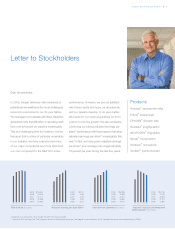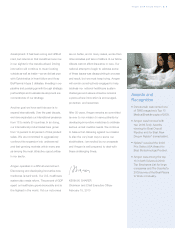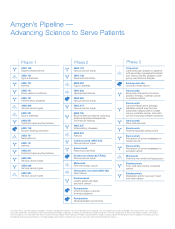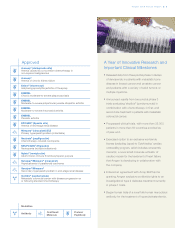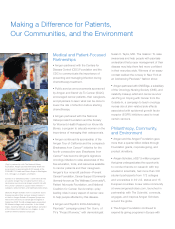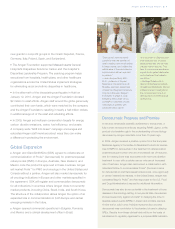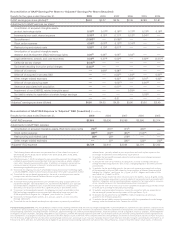Amgen 2009 Annual Report Download - page 13
Download and view the complete annual report
Please find page 13 of the 2009 Amgen annual report below. You can navigate through the pages in the report by either clicking on the pages listed below, or by using the keyword search tool below to find specific information within the annual report.PART I
Item 1. BUSINESS
Overview
Amgen Inc. (including its subsidiaries, referred to as “Amgen,” “the Company,” “we,” “our” and “us”) is
the world’s largest independent biotechnology medicines company. We discover, develop, manufacture and
market medicines for grievous illnesses. We focus solely on human therapeutics and concentrate on innovating
novel medicines based on advances in cellular and molecular biology. Our mission is to serve patients.
We were incorporated in 1980 and organized as a Delaware corporation in 1987. Our public website is
www.amgen.com. On our website, investors can find press releases, financial filings and other information about
the Company. The U.S. Securities and Exchange Commission (“SEC”) website, www.sec.gov, also offers access
to reports and documents Amgen has filed electronically with the SEC. These website addresses are not intended
to function as hyperlinks, and the information contained in our website and in the SEC’s website is not intended
to be a part of this filing.
As of December 31, 2009, we had 17,200 staff members worldwide. Approximately 6,600 of our staff mem-
bers work in our research and development (“R&D”) function; approximately 4,700 work in manufacturing;
approximately 3,900 work in our commercial operations and the rest are in general and administrative functions.
Currently, we market primarily recombinant protein therapeutics in supportive cancer care, nephrology and
inflammation. Our principal products are: Aranesp®(darbepoetin alfa) and EPOGEN®(Epoetin alfa),
erythropoietic-stimulating agents (“ESAs”) that stimulate the production of red blood cells; Neulasta®
(pegfilgrastim), a pegylated protein, based on the Filgrastim molecule, and NEUPOGEN®(Filgrastim), a
recombinant-methionyl human granulocyte colony-stimulating factor (“G-CSF”), both of which selectively stim-
ulate the production of neutrophils (a type of white blood cell that helps the body fight infection), and Enbrel®
(etanercept), an inhibitor of tumor necrosis factor (“TNF”), a substance that plays a role in the body’s response to
inflammatory diseases. Our principal products represented 93%, 94% and 95% of our sales in 2009, 2008 and
2007, respectively. Our other marketed products include: Sensipar®/Mimpara®(cinacalcet), a small molecule
calcimimetic that lowers serum calcium levels; Vectibix®(panitumumab), a fully human monoclonal antibody
that binds specifically to the epidermal growth factor receptor (“EGFr”) and Nplate®(romiplostim), a thrombo-
poietin (“TPO”) receptor agonist that mimics endogenous TPO, the primary driver of platelet production.
In addition to our marketed products, we have products in mid-to-late stage development in various ther-
apeutic areas, including oncology, hematology, inflammation, bone, nephrology and general medicine, which
includes cardiology and neurology. Denosumab, our leading late-stage product candidate, is a fully human
monoclonal antibody that specifically targets a ligand known as RANKL (that binds to a receptor known as
RANK), an essential regulator of osteoclasts (the cells that break down bone) that is under regulatory review and
is being studied across a range of conditions. Our R&D organization has expertise in multiple treatment modal-
ities, including large molecules (such as proteins, antibodies and peptibodies) and small molecules.
We maintain sales and marketing forces primarily in the United States, Europe and Canada. We market our
products to healthcare providers, including physicians or their clinics, dialysis centers, hospitals and pharmacies.
Most patients receiving our principal products for approved indications are covered by either government or pri-
vate payer healthcare programs, which influence demand. The reimbursement environment is evolving with
greater emphasis on cost containment and in demonstrating the economic value of products.
Drug development in our industry is complex, challenging and risky. Product development cycles are very
long — approximately 10 to 15 years from discovery to market – and failure rates are high. A new medicine must
undergo many years of preclinical and clinical testing to establish safety and efficacy for use in humans at
appropriate dosing levels with an acceptable benefit-risk profile. Biotechnology products, which are produced in
living systems, are inherently complex due to naturally-occurring molecular variations. Highly specialized
knowledge and extensive process and product characterization are required to transform laboratory scale proc-
esses into reproducible commercial manufacturing processes. Upon approval, marketed products in our industry
1


